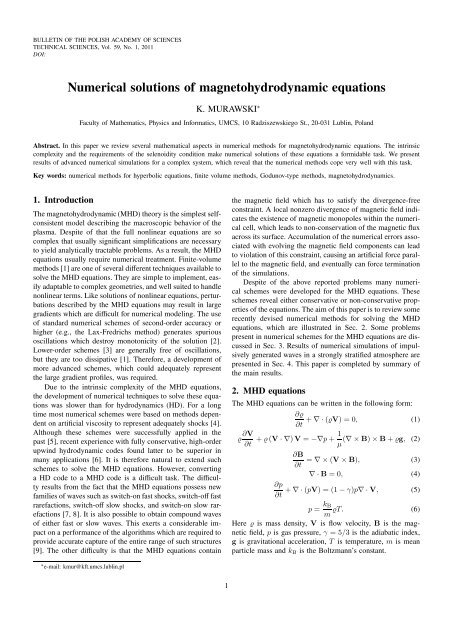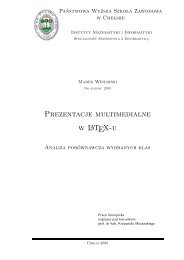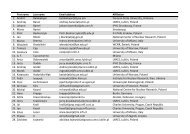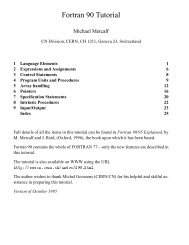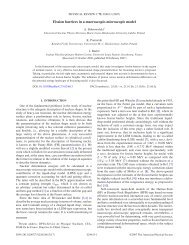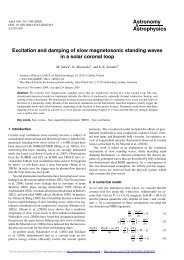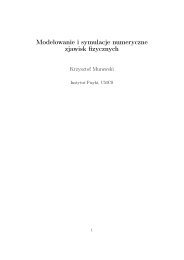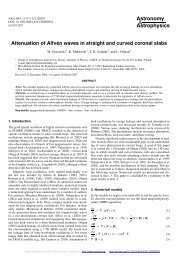Numerical solutions of magnetohydrodynamic equations - Lublin
Numerical solutions of magnetohydrodynamic equations - Lublin
Numerical solutions of magnetohydrodynamic equations - Lublin
Create successful ePaper yourself
Turn your PDF publications into a flip-book with our unique Google optimized e-Paper software.
BULLETIN OF THE POLISH ACADEMY OF SCIENCES<br />
TECHNICAL SCIENCES, Vol. 59, No. 1, 2011<br />
DOI:<br />
<strong>Numerical</strong> <strong>solutions</strong> <strong>of</strong> <strong>magnetohydrodynamic</strong> <strong>equations</strong><br />
K. MURAWSKI ∗<br />
Faculty <strong>of</strong> Mathematics, Physics and Informatics, UMCS, 10 Radziszewskiego St., 20-031 <strong>Lublin</strong>, Poland<br />
Abstract. In this paper we review several mathematical aspects in numerical methods for <strong>magnetohydrodynamic</strong> <strong>equations</strong>. The intrinsic<br />
complexity and the requirements <strong>of</strong> the selenoidity condition make numerical <strong>solutions</strong> <strong>of</strong> these <strong>equations</strong> a formidable task. We present<br />
results <strong>of</strong> advanced numerical simulations for a complex system, which reveal that the numerical methods cope very well with this task.<br />
Key words: numerical methods for hyperbolic <strong>equations</strong>, finite volume methods, Godunov-type methods, <strong>magnetohydrodynamic</strong>s.<br />
1. Introduction<br />
The <strong>magnetohydrodynamic</strong> (MHD) theory is the simplest selfconsistent<br />
model describing the macroscopic behavior <strong>of</strong> the<br />
plasma. Despite <strong>of</strong> that the full nonlinear <strong>equations</strong> are so<br />
complex that usually significant simplifications are necessary<br />
to yield analytically tractable problems. As a result, the MHD<br />
<strong>equations</strong> usually require numerical treatment. Finite-volume<br />
methods [1] are one <strong>of</strong> several different techniques available to<br />
solve the MHD <strong>equations</strong>. They are simple to implement, easily<br />
adaptable to complex geometries, and well suited to handle<br />
nonlinear terms. Like <strong>solutions</strong> <strong>of</strong> nonlinear <strong>equations</strong>, perturbations<br />
described by the MHD <strong>equations</strong> may result in large<br />
gradients which are difficult for numerical modeling. The use<br />
<strong>of</strong> standard numerical schemes <strong>of</strong> second-order accuracy or<br />
higher (e.g., the Lax-Fredrichs method) generates spurious<br />
oscillations which destroy monotonicity <strong>of</strong> the solution [2].<br />
Lower-order schemes [3] are generally free <strong>of</strong> oscillations,<br />
but they are too dissipative [1]. Therefore, a development <strong>of</strong><br />
more advanced schemes, which could adequately represent<br />
the large gradient pr<strong>of</strong>iles, was required.<br />
Due to the intrinsic complexity <strong>of</strong> the MHD <strong>equations</strong>,<br />
the development <strong>of</strong> numerical techniques to solve these <strong>equations</strong><br />
was slower than for hydrodynamics (HD). For a long<br />
time most numerical schemes were based on methods dependent<br />
on artificial viscosity to represent adequately shocks [4].<br />
Although these schemes were successfully applied in the<br />
past [5], recent experience with fully conservative, high-order<br />
upwind hydrodynamic codes found latter to be superior in<br />
many applications [6]. It is therefore natural to extend such<br />
schemes to solve the MHD <strong>equations</strong>. However, converting<br />
a HD code to a MHD code is a difficult task. The difficulty<br />
results from the fact that the MHD <strong>equations</strong> possess new<br />
families <strong>of</strong> waves such as switch-on fast shocks, switch-<strong>of</strong>f fast<br />
rarefactions, switch-<strong>of</strong>f slow shocks, and switch-on slow rarefactions<br />
[7, 8]. It is also possible to obtain compound waves<br />
<strong>of</strong> either fast or slow waves. This exerts a considerable impact<br />
on a performance <strong>of</strong> the algorithms which are required to<br />
provide accurate capture <strong>of</strong> the entire range <strong>of</strong> such structures<br />
[9]. The other difficulty is that the MHD <strong>equations</strong> contain<br />
the magnetic field which has to satisfy the divergence-free<br />
constraint. A local nonzero divergence <strong>of</strong> magnetic field indicates<br />
the existence <strong>of</strong> magnetic monopoles within the numerical<br />
cell, which leads to non-conservation <strong>of</strong> the magnetic flux<br />
across its surface. Accumulation <strong>of</strong> the numerical errors associated<br />
with evolving the magnetic field components can lead<br />
to violation <strong>of</strong> this constraint, causing an artificial force parallel<br />
to the magnetic field, and eventually can force termination<br />
<strong>of</strong> the simulations.<br />
Despite <strong>of</strong> the above reported problems many numerical<br />
schemes were developed for the MHD <strong>equations</strong>. These<br />
schemes reveal either conservative or non-conservative properties<br />
<strong>of</strong> the <strong>equations</strong>. The aim <strong>of</strong> this paper is to review some<br />
recently devised numerical methods for solving the MHD<br />
<strong>equations</strong>, which are illustrated in Sec. 2. Some problems<br />
present in numerical schemes for the MHD <strong>equations</strong> are discussed<br />
in Sec. 3. Results <strong>of</strong> numerical simulations <strong>of</strong> impulsively<br />
generated waves in a strongly stratified atmosphere are<br />
presented in Sec. 4. This paper is completed by summary <strong>of</strong><br />
the main results.<br />
2. MHD <strong>equations</strong><br />
The MHD <strong>equations</strong> can be written in the following form:<br />
∂̺<br />
+ ∇ · (̺V) = 0,<br />
∂t<br />
(1)<br />
̺∂V<br />
∂t + ̺ (V · ∇)V = −∇p + 1 (∇ × B) × B + ̺g, (2)<br />
µ<br />
∂B<br />
= ∇ × (V × B),<br />
∂t<br />
(3)<br />
∇ · B = 0, (4)<br />
∂p<br />
+ ∇ · (pV) = (1 − γ)p∇ · V,<br />
∂t<br />
(5)<br />
p = k B ̺T. (6)<br />
m<br />
Here ̺ is mass density, V is flow velocity, B is the magnetic<br />
field, p is gas pressure, γ = 5/3 is the adiabatic index,<br />
g is gravitational acceleration, T is temperature, m is mean<br />
particle mass and k B is the Boltzmann’s constant.<br />
∗ e-mail: kmur@kft.umcs.lublin.pl<br />
1
K. Murawski<br />
is the pressure scale-height, and p 0 denotes the gas pressure<br />
at the reference level, y = y r , which we choose and set fixed<br />
as y r = 10 Mm.<br />
We adopt a realistic temperature pr<strong>of</strong>ile T(y) for the solar<br />
atmosphere [30], which is displayed in Fig. 1. Note that T<br />
attains a value <strong>of</strong> about 5700 K at the top <strong>of</strong> the photosphere<br />
which corresponds to y = 0.5 Mm. At higher altitudes T(y)<br />
falls <strong>of</strong>f until it reaches its minimum <strong>of</strong> 4350 K at the altitude<br />
<strong>of</strong> y ≃ 0.95 Mm. Higher up T(y) grows gradually with height<br />
up to the transition region which is located at y ≃ 2.7 Mm.<br />
Here T(y) experiences a sudden growth up to the coronal<br />
value <strong>of</strong> 1.5 MK at y = 10 Mm. Having specified T(y) with<br />
a use <strong>of</strong> Eqs. (55) and (60) we can obtain mass density and<br />
gas pressure pr<strong>of</strong>iles.<br />
Fig. 1. Equilibrium temperature (in Kelvins) pr<strong>of</strong>ile vs. height y (in<br />
Mm) for the solar atmosphere<br />
For the initial magnetic field, we adopt the model which<br />
was devised by Priest [31]. In this model, we assume that<br />
magnetic field is current-free (∇ × B = 0) and potential<br />
(B = ∇ × (Aẑ)) with the magnetic flux function<br />
A(x, y) = B 0 Λ B cos(x/Λ B )exp[−(y − y r )/Λ B ] . (58)<br />
Here B 0 denotes the magnetic field at y = y r and Λ B = 2L/π<br />
is the magnetic scale-height. We choose 2L = 30 Mm which<br />
correspond to the size <strong>of</strong> a supergranular cell. It is noteworthy<br />
that the magnetic field is predominantly vertical at supergranular<br />
boundaries (x = 0, x = 2L), while it reveals a horizontal<br />
canopy structure at the supergranular center (x = L).<br />
A magnitude <strong>of</strong> magnetic field is chosen to specify at<br />
y = y r the plasma β = 2µp/B 2 = 2c 2 s /(γc2 A ) equal to 0.048.<br />
Here the sound speed c s = √ γp/̺ and the Alfvén speed,<br />
c A = √ B 2 /(µ̺). Figure 2 illustrates vertical pr<strong>of</strong>ile <strong>of</strong> the<br />
plasma β which attains a value <strong>of</strong> about 0.015 around the<br />
transition region, y ≃ 2.7 Mm, while it grows with depth<br />
reaching a value <strong>of</strong> about 6 at y = 1.5 Mm that is located<br />
within the solar chromosphere. This growth results from the<br />
abrupt increase <strong>of</strong> gas pressure there.<br />
Fig. 2. The plasma β pr<strong>of</strong>ile vs. height y<br />
We excite waves in the above described solar atmosphere<br />
by launching initially, at t = 0, the Gaussian pulse in a vertical<br />
component <strong>of</strong> velocity V y , i.e.<br />
V y (x, y, t = 0) = A v exp<br />
[− x2 + (y − y 0 ) 2 ]<br />
w 2 . (59)<br />
Here A v = 5 km s −1 is the amplitude <strong>of</strong> the pulse, y 0 =<br />
0.5 Mm is its vertical position and w = 0.3 Mm is its width.<br />
Equations (1)–(6) are solved numerically using the code<br />
FLASH [27] which implements a second-order unsplit Godunov<br />
solver and Adaptive Mesh Refinement (AMR). We set<br />
the simulation box as (−15, 15) Mm ×(−0.5, 29.5) Mm and<br />
fix at all four boundaries <strong>of</strong> the simulation region the plasma<br />
quantities to their equilibrium values. In our studies we use<br />
AMR grid with a minimum (maximum) level <strong>of</strong> refinement<br />
blocks set to 5 (8). The refinement strategy is based on controlling<br />
numerical errors in a gradient <strong>of</strong> mass density. Such<br />
settings result in an excellent resolution <strong>of</strong> steep spatial pr<strong>of</strong>iles,<br />
which significantly reduce numerical diffusion within<br />
the simulation region.<br />
Figure 3 illustrates spatial pr<strong>of</strong>iles <strong>of</strong> log̺ and velocity<br />
vectors at t = 250 s (left panel) and t = 1500 s (right<br />
panel). The initial pulse splits in a usual way into counterpropagating<br />
waves. The wave propagating upwards grows in<br />
its amplitude as a result <strong>of</strong> the rapid decrease <strong>of</strong> mass density<br />
in the chromosphere. As a consequence <strong>of</strong> that a shock<br />
results in. Photospheric and chromospheric plasma is lifted<br />
up by underpressure which settles in below the shock. The<br />
pressure gradient force overwhelms gravity and it pushes the<br />
photospheric and chromospheric material towards the solar<br />
corona. This scenario is clearly seen at t = 250 s. At a later<br />
time the plasma becomes attracted by gravity and as a result is<br />
falls <strong>of</strong>f towards the low layers. However, the secondary shock<br />
which results from the original pulse works against this fall <strong>of</strong>f<br />
as it lifts up the photospheric and chromospheric plasma. As<br />
a result, a complex bi-directional flows arises. The whole scenario<br />
bares many features <strong>of</strong> solar spicules. It is noteworthy<br />
that the magnetic field-free case, B = 0, was recently discussed<br />
by Gruszecki et al. [32] who revealed similar features<br />
<strong>of</strong> quasi-periodic shocks traveling from the chromosphere to<br />
the corona. However, in this hydrodynamic case spatial wave<br />
pr<strong>of</strong>iles were more symmetric in space and spicules were not<br />
observed.<br />
6 Bull. Pol. Ac.: Tech. 59(1) 2011
<strong>Numerical</strong> <strong>solutions</strong> <strong>of</strong> <strong>magnetohydrodynamic</strong> <strong>equations</strong><br />
Fig. 3. Mass density (colour maps, log scale) and velocity (arrows) pr<strong>of</strong>iles at t = 250 s (left panel) and t = 1500 s (right panel). Mass<br />
density and velocity are expressed in units <strong>of</strong> 10 −12 kg m −3 and 1 Mm s −1 , respectively<br />
Figure 4 displays time-signatures <strong>of</strong> the vertical component<br />
<strong>of</strong> velocity for the case <strong>of</strong> Fig. 3. This velocity is collected<br />
in time at the detection point (x = 0, y = 20) Mm.<br />
The arrival <strong>of</strong> the shock front to the detection point occurs at<br />
t ≃ 200 s. The second, third, and fourth shocks fronts reach<br />
the detection point at t ≃ 350 s, t ≃ 650 s, and t ≃ 950 s,<br />
respectively. This secondary shock results from the nonlinear<br />
wake which lags behind the leading signal. In the linear approximation<br />
and magnetic-free case, the wake oscillates with<br />
the acoustic cut-<strong>of</strong>f frequency<br />
Ω ac = c s<br />
2Λ<br />
√<br />
1 + 2 dΛ<br />
dy . (60)<br />
Fig. 4. The plasma β pr<strong>of</strong>ile vs. height y<br />
This scenario consists the building block <strong>of</strong> onedimensional<br />
(1D) rebound shock model <strong>of</strong> [33] who proposed<br />
that the secondary shock (or rebound shock) lifts up the transition<br />
region higher than the first shock thereby resulting in<br />
a spicule appearance at observed heights. The process is well<br />
studied in the frame <strong>of</strong> 1D numerical simulations. However,<br />
our 2D numerical simulations introduce new interesting<br />
features in comparison to the 1D rebound shock scenario.<br />
There are few conclusions which result from our simulations:<br />
a) according to the theory <strong>of</strong> Klein-Gordon equation an initial<br />
pulse generates a wave front and a trailing wake which<br />
oscillates with acoustic cut-<strong>of</strong>f frequency [33];<br />
b) even a small amplitude initial pulse launched at the top<br />
<strong>of</strong> the photosphere exhibits a tendency to generate shocks.<br />
These shocks result from a nonlinear wake.<br />
5. Summary<br />
This paper presents several mathematical aspects in numerical<br />
methods for <strong>magnetohydrodynamic</strong> <strong>equations</strong>. Although<br />
this presentation is far from complete the emphasis is on the<br />
methods which are the most effective and the best known to<br />
the author.<br />
There are several conditions that numerical schemes<br />
should satisfy: accuracy and speed <strong>of</strong> numerical simulations,<br />
adequate representation <strong>of</strong> complex flows and steep pr<strong>of</strong>iles,<br />
lack <strong>of</strong> generation <strong>of</strong> spurious oscillations as well as robustness.<br />
A computer code is called robust if it has the virtue <strong>of</strong><br />
giving reliable results to a wide range <strong>of</strong> problems without<br />
needing to be retuned. <strong>Numerical</strong> schemes such as shockcapturing<br />
schemes described in this paper satisfy these conditions.<br />
Bull. Pol. Ac.: Tech. 59(1) 2011 7
K. Murawski<br />
Existing numerical models such as was used in Sec. 4<br />
with an adaptation <strong>of</strong> the FLASH code demonstrate the feasibility<br />
<strong>of</strong> fluid simulations in obtaining at least qualitative and,<br />
to some extent, quantitative features in the magnetized fluid.<br />
With continued improvements in computational methods<br />
and computer resources, the usefulness and capability <strong>of</strong> the<br />
numerical approach should continue to improve.<br />
Acknowledgements. The s<strong>of</strong>tware used in this work was in<br />
part developed by the DOE-supported ASCI/Alliance Center<br />
for Astrophysical Thermonuclear Flashes at the University <strong>of</strong><br />
Chicago.<br />
REFERENCES<br />
[1] E. Toro, Riemann Solvers and <strong>Numerical</strong> Methods for Fluid<br />
Dynamics, Springer, Berlin, 2009.<br />
[2] R.J. LeVeque, Finite-volume Methods for Hyperbolic Problems,<br />
Cambridge University Press, Cambridge, 2002.<br />
[3] S.K. Godunov, “A difference scheme for numerical solution <strong>of</strong><br />
discontinuos solution <strong>of</strong> hydrodynamic <strong>equations</strong>”, Math. Sb.<br />
47, 271–306 (1959).<br />
[4] J.M. Stone and M.L. Norman, “ZEUS-2D: a radiation <strong>magnetohydrodynamic</strong>s<br />
code for astrophysical flows in two space dimensions.<br />
II. The <strong>magnetohydrodynamic</strong> algorithms and tests”,<br />
Astrophys. J. Suppl. Ser. 80, 791–818 (1992).<br />
[5] K. Murawski and R.S. Steinolfson, “<strong>Numerical</strong> modeling <strong>of</strong><br />
the solar wind interaction with Venus”, Planet. Space Sci. 44,<br />
243–252 (1996).<br />
[6] K. Murawski and D. Lee, “<strong>Numerical</strong> methods <strong>of</strong> solving<br />
<strong>equations</strong> <strong>of</strong> hydrodynamics from perspectives <strong>of</strong> the code<br />
FLASH”, Bull. Pol. Ac.: Tech. 59 (1), 81–91 (2011).<br />
[7] P.R. Woodward and P. Colella, “The numerical simulation <strong>of</strong><br />
two-dimensional fluid flow with strong shocks”, J. Comp. Phys.<br />
54, 115–173 (1984).<br />
[8] P.L. Roe and D.S. Balsara, “Notes on the eigensystem <strong>of</strong> <strong>magnetohydrodynamic</strong>s”,<br />
SIAM J. Appl. Math. 56, 57–67 (1996).<br />
[9] A.A. Barmin, A.G. Kulikovskiy, and N.V. Pogorelov, “Shockcapturing<br />
approach and nonevolutionary <strong>solutions</strong> in <strong>magnetohydrodynamic</strong>s”,<br />
J. Comp. Phys. 126, 77–90 (1996).<br />
[10] J.U. Brackbill and D.C. Barnes, “The effect <strong>of</strong> nonzero ∇ · B<br />
on the numerical solution <strong>of</strong> the <strong>magnetohydrodynamic</strong> <strong>equations</strong>”,<br />
J. Comp. Phys. 35, 426 (1980).<br />
[11] K. Murawski, Analytical and <strong>Numerical</strong> Methods for Wave<br />
Propagation in Fluids, World Scientific, Singapore, 2002.<br />
[12] M. Brio and C.C. Wu, “An upwind differencing scheme for the<br />
<strong>equations</strong> <strong>of</strong> ideal <strong>magnetohydrodynamic</strong>s”, J. Comp. Phys. 75,<br />
400–422 (1988).<br />
[13] J.A. Rossmanith, “An unstaggered, high-resolution constrained<br />
transport method for <strong>magnetohydrodynamic</strong> flows”, SIAM J.<br />
Sci. Comp. 28, 1766–1797 (2006).<br />
[14] U. Ziegler, “The NIRVANA code: Parallel computational MHD<br />
with adaptive mesh refinement”, Computer Phys. Comm. 179,<br />
227–244 (2008).<br />
[15] J.M. Stone, T.A. Gardiner, P. Teuben, J.F. Hawley, and J.B. Simon,<br />
“Athena: a new code for astrophysical MHD”, Astrophysical<br />
J. Supplement Series 178, 137–177 (2008).<br />
[16] K.G. Powell, “An approximate Riemann solver for <strong>magnetohydrodynamic</strong>s”,<br />
ICASE Report 94–24, CD-ROM (1994).<br />
[17] A.L. Zachary and P. Colella, “A higher-order Godunov method<br />
for the <strong>equations</strong> <strong>of</strong> ideal <strong>magnetohydrodynamic</strong>s”, J. Comp.<br />
Phys. 99, 341–347 (1992).<br />
[18] D.V. Abeele, “Development <strong>of</strong> a Godunov-type solver for 2D<br />
ideal MHD problems”, Project Rep. 1, CD-ROM 1995.<br />
[19] P.J. Dellar, “A note on magnetic monopoles and the one dimensional<br />
MHD Riemann problem”, J. Comp. Phys. 172, 392–398<br />
(2001).<br />
[20] Ch. Helzel, J.A. Rossmanith, and B. Taetz, “An unstaggered<br />
constrained transport method for the 3D ideal <strong>magnetohydrodynamic</strong><br />
<strong>equations</strong>”, eprint arXiv:1007.2606, (2010).<br />
[21] A. Dedner, F. Kemm, D. Kröner, C.-D. Munz, T. Schnitzer,<br />
and M. Wesenberg M., “Hyperbolic divergence cleaning for<br />
the MHD <strong>equations</strong>”, J. Comp. Phys. 175, 645–673 (2002).<br />
[22] C.R. DeVore, “Flux-corrected transport techniques for multidimensional<br />
compressible <strong>magnetohydrodynamic</strong>s”, J. Comp.<br />
Phys. 92, 142–160 (1991).<br />
[23] D. Lee and A.E. Deane, “An unsplit staggered mesh scheme<br />
for multidimensional <strong>magnetohydrodynamic</strong>s”, J. Comp. Phys.<br />
228 (4), 952–975 (2009).<br />
[24] T. Tanaka, “Configurations <strong>of</strong> the solar wind flow and magnetic<br />
field around the planets with no magnetic field: calculation by<br />
a new MHD simulation scheme”, J. Geophys. Res. 98, 17251–<br />
17262 (1993).<br />
[25] G. Tóth, “The ∇ ·B = 0 constraint in shock-capturing <strong>magnetohydrodynamic</strong>s<br />
codes”, J. Comp. Phys. 161, 605–652 (2000).<br />
[26] T.I. Gombosi, D.L. De Zeeuw, R.M. Häberli, and K.G. Powell,<br />
“Axisymmetric modeling <strong>of</strong> cometary mass loading on an<br />
adaptively refined grid: MHD results”, J. Geophys. Res. 99<br />
(21), 525–521, 539 (1994).<br />
[27] N. Aslan, “MHD-A: A fluctuation splitting wave model for<br />
planar <strong>magnetohydrodynamic</strong>s”, J. Comp. Phys. 153, 437–466<br />
(1999).<br />
[28] K.G. Powell, P.L. Roe, T.J. Linde, T.I. Gombosi, and D.L. De<br />
Zeeuw, “A solution-adaptive upwind scheme for ideal <strong>magnetohydrodynamic</strong>s”,<br />
J. Comp. Phys. 154, 284–309 (1999).<br />
[29] P. Janhunen, “A positive conservative method for <strong>magnetohydrodynamic</strong>s<br />
based on HLL and Roe methods”, J. Comp. Phys.<br />
160, 649–661 (2000).<br />
[30] J.E. Vernazza, E.H. Avrett, and R. Loeser, “Structure <strong>of</strong> the<br />
solar chromosphere. III – Models <strong>of</strong> the EUV brightness components<br />
<strong>of</strong> the quiet-sun”, Astrophysical J. 45, 635–725 (1981).<br />
[31] E.R. Priest, Solar Magnetohydrodynamics, Reidel Publishing<br />
Company, Dordrecht, 1982.<br />
[32] M. Gruszecki, K. Murawski, A.G. Kosovichev, K.V. Parchevsky,<br />
and T. Zaqarashvili, “<strong>Numerical</strong> simulations <strong>of</strong> impulsively<br />
excited acoustic-gravity waves in a stellar atmosphere”,<br />
Acta Phys. Polonica, to be published (2011).<br />
[33] J.V. Hollweg, “On the origin <strong>of</strong> solar spicules”, Astrophys. J.<br />
257, 345–353 (1982).<br />
8 Bull. Pol. Ac.: Tech. 59(1) 2011


